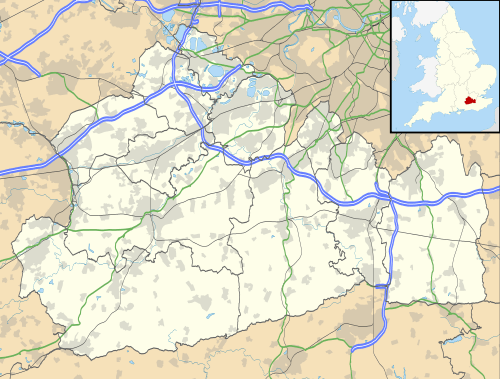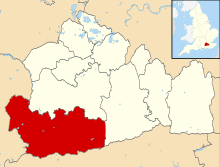Salvation Army Hall
The former Salvation Army Hall in Godalming, Surrey, England, now an office building known as Aurum House, has been used by three religious groups since its construction c. 1830. The ancient town in the English county of Surrey has a long and diverse history of Protestant Nonconformity, and three Nonconformst denominations are represented: at first it served Congregationalists, but when they built a larger chapel in the town it passed to the Methodist Church. In the 20th century it was occupied by The Salvation Army, but it closed in 2012 and was redeveloped for commercial use. The building has been listed at Grade II for its architectural and historical importance.
| Salvation Army Hall | |||||||||||||||||||||||||||||||||||||
|---|---|---|---|---|---|---|---|---|---|---|---|---|---|---|---|---|---|---|---|---|---|---|---|---|---|---|---|---|---|---|---|---|---|---|---|---|---|
The former Salvation Army hall in 2015 after conversion into an office
| |||||||||||||||||||||||||||||||||||||
| |||||||||||||||||||||||||||||||||||||
History
Godalming is an ancient town with mainly industrial origins,[1] which were conducive to the spread of Nonconformism.[2] Attendances at conventicles exceeded those at the parish church, St Peter and St Paul's, where the Anglo-Catholic views of the priest in the late 17th century did not represent the majority of inhabitants, who were "overwhelmingly Puritan in belief and practice". Numerous informal Nonconformist groups developed in and around Godalming at this time.[3]
One such group was Congregationalists, which had a sufficient following by 1730 they acquired land on Hart's Lane and built a chapel.[1][4] The congregation "may be considered ... the lineal representative of the conventicle of the reign of Charles II", which had 700–800 worshippers every Sunday at a time when Godalming's population was 3,000.[1] Hart's Lane, now known as Mint Street, is one of several small streets immediately west of the town centre, characterised by small, unrestored 16th- and 17th-century cottages. (Proposals to demolish these streets and all the buildings in favour of a ring road were made in 1969 but were not acted upon.)[5] The land for the chapel was bought for £20 in January 1729, and construction soon followed.[6] Ebenezer Chapel, as it was called,[4] was put under the charge of the Surrey Congregational Mission in 1799. In the early 19th century it was served by a succession of student pastors from Homerton College, Cambridge. One, John Nelson Goulty, later came to prominence during his 37-year incumbency at Union Chapel, Brighton. During his much shorter stay in Godalming, "the cause considerably revived" and he also preached in the nearby villages of Elstead and Hascombe.[7]
The building was extended at the rear in 1821 as the congregation grew,[4] then in about 1830 it was rebuilt on the same site[2][8] at a cost of £634.[9] By January 1867, though, the congregation had expanded so much that a new chapel was needed,[10] and the trustees decided to sell the Mint Street building. Land at Bridge Street was found and purchased and the new Congregational chapel was quickly built, opening on 28 October 1868.[11] The former chapel was then bought by a group of Wesleyan Methodists for £450,[12] and they converted it into Godalming's first permanent Methodist chapel. (A Methodist group had existed for some years until 1797, and meetings recommenced in 1826 in a hired room; a small chapel was also built at Farncombe, the neighbouring village, in 1840.) As Godalming Wesleyan Chapel it opened in 1869, and the congregation grew steadily.[13] It was in turn replaced by a new church—the Hugh Price Hughes Memorial Chapel (now Godalming United Church)—on Bridge Street, almost opposite the Congregational chapel, in 1903.[2][8][10] The Methodist Church retained the Mint Street building at first and leased it to a Salvation Army congregation, then sold it to them in 1918.[2] Alterations were made in 1930, and the windows were also replaced in the 20th century. In 1990 the building was reported to be "in a state of disrepair",[14] but further alterations were made by 1994.[8] The Salvation Army stopped using the hall with effect from 29 September 2012.[15] A planning application to convert the disused hall into an office was submitted in May 2013 and approved by Waverley Borough Council two months later.[16]
While it was still in use by the Salvation Army, the building was listed at Grade II on 21 August 1990.[14] Such buildings are defined as "nationally important and of special interest".[17] As of February 2001, it was one of 1,548 Grade II listed buildings and 1,661 listed buildings of all grades in the Borough of Waverley,[18] the local government district in which Godalming is situated.[19] It was also licensed for worship in accordance with the Places of Worship Registration Act 1855 and had the registration number 39828.[20] It is one of several current and former places of worship in Godalming with listed status: the Quaker meeting house on Mill Street,[21] St Edmund's Roman Catholic Church,[22] Meadrow Unitarian Chapel[23] and the Congregational church on Bridge Street[24] (which superseded the Mint Street building but which is no longer in religious use) are all Grade II-listed, and St Peter and St Paul's parish church has Grade I status.[25]
Architecture
The walls of the building are of Bargate stone rubble.[14] The coarse, light-brown sandstone was quarried locally for many years and was used in many medieval and 19th-century churches.[26] There are brick dressings to the stonework and rusticated quoins, and the façade is of brick laid in the Flemish bond pattern and painted over. The three-bay façade faces Mint Street and is topped by a gabled pediment with an entablature. There are three bays to the side elevations as well. The entrance is centrally placed with one window (set into an architrave) on each side. The rear and side elevations have arched windows, unlike those at the front which are straight-headed.[14][8] Inside, when inspected in the 1990s, a pulpit stood on the north wall between the windows, and there had been a gallery on the south wall which was replaced with a room on the upper storey.[8]
See also
| Wikimedia Commons has media related to Salvation Army Hall, Godalming. |
References
Notes
- Malden, H. E. (ed) (1911). "A History of the County of Surrey: Volume 3. Parishes: Godalming". Victoria County History of Surrey. British History Online. pp. 24–42. Retrieved 3 October 2015.CS1 maint: extra text: authors list (link)
- Janaway 1987, p. 64.
- Stock 1999, p. 5.
- Stock 1999, p. 28.
- Nairn & Pevsner 1971, p. 257.
- Cleal & Crippen 1908, p. 402.
- Cleal & Crippen 1908, pp. 402–403.
- Stell 2002, p. 324.
- Cleal & Crippen 1908, p. 403.
- Stock 1999, p. 30.
- Head 1990, §. 62.
- Cleal & Crippen 1908, p. 404.
- Stock 1999, p. 38.
- Historic England. "Salvation Army Meeting Hall, 18 Mint Street (north side), Godalming (Grade II) (1044475)". National Heritage List for England. Retrieved 4 October 2015.
- Honeysett, Ian (2012). "Surrey Churches Ride and Stride 2012". Church of St. Edmund King and Martyr, Godalming. Archived from the original on 18 April 2015. Retrieved 4 October 2015.
- "Planning Application Record : WA/2013/0833". Waverley planning application WA/2013/0833. Waverley Borough Council. 2015. Archived from the original on 4 October 2015. Retrieved 4 October 2015.
Former Salvation Army Hall, Mint Street, Godalming GU7 1HE: Change of Use from former Meeting Hall (Class D1) to Office Use (Class B1)
- "Listed Buildings". English Heritage. 2012. Archived from the original on 24 January 2013. Retrieved 24 January 2013.
- "Images of England – Statistics by County (Surrey)". Images of England. English Heritage. 2007. Archived from the original on 31 May 2013. Retrieved 29 September 2015.
- "Godalming Directory – Waverley Borough Council". Godalming Town Council. 2015. Archived from the original on 29 September 2015. Retrieved 29 September 2015.
- Registered in accordance with the Places of Worship Registration Act 1855 (Number in Worship Register: 39828; Name: Salvation Army Halls; Address: Mint Street, Godalming; Denomination: Salvation Army). Retrieved 4 October 2015. (Archived version of list from April 2010; Click here for access to subsequent updates)
- Historic England. "Friends Meeting House, Mill Lane (south side), Godalming (Grade II) (1352714)". National Heritage List for England. Retrieved 5 October 2015.
- Historic England. "Church of St Edmund King and Martyr, Croft Road (south side), Godalming (Grade II) (1189582)". National Heritage List for England. Retrieved 5 October 2015.
- Historic England. "Unitarian Chapel and Cottage, Meadrow (east side), Godalming (Grade II) (1044505)". National Heritage List for England. Retrieved 5 October 2015.
- Historic England. "Former Congregational Church and attached Sunday School, now Messenger, May & Baverstock Premises, Bridge Street (north-west side), Godalming (Grade II) (1294577)". National Heritage List for England. Retrieved 5 October 2015.
- Historic England. "Church of St Peter and St Paul, Church Street (east side), Godalming (Grade I) (1044546)". National Heritage List for England. Retrieved 5 October 2015.
- Nairn & Pevsner 1971, pp. 79–80.
Bibliography
- Cleal, Edward E.; Crippen, T. G. (1908). The story of Congregationalism in Surrey. London: James Clarke & Co. Retrieved 10 June 2013.CS1 maint: ref=harv (link)
- Janaway, John (1987). Yesterday's Town: Godalming. Buckingham: Barracuda Books Ltd. ISBN 0-86023-291-3.CS1 maint: ref=harv (link)
- Nairn, Ian; Pevsner, Nikolaus (1971) [1962]. The Buildings of England: Surrey (2nd ed.). Harmondsworth: Penguin Books. ISBN 0-300-09675-5.CS1 maint: ref=harv (link)
- Stell, Christopher (2002). Nonconformist Chapels and Meeting-houses in Eastern England. Swindon: English Heritage. ISBN 1-873592-50-7.CS1 maint: ref=harv (link)
- Stock, Peter (1999). Hidden Nonconformity: a study of Nonconformity in the Godalming area from the 17th century. Farnham: Arrow Press.CS1 maint: ref=harv (link)

